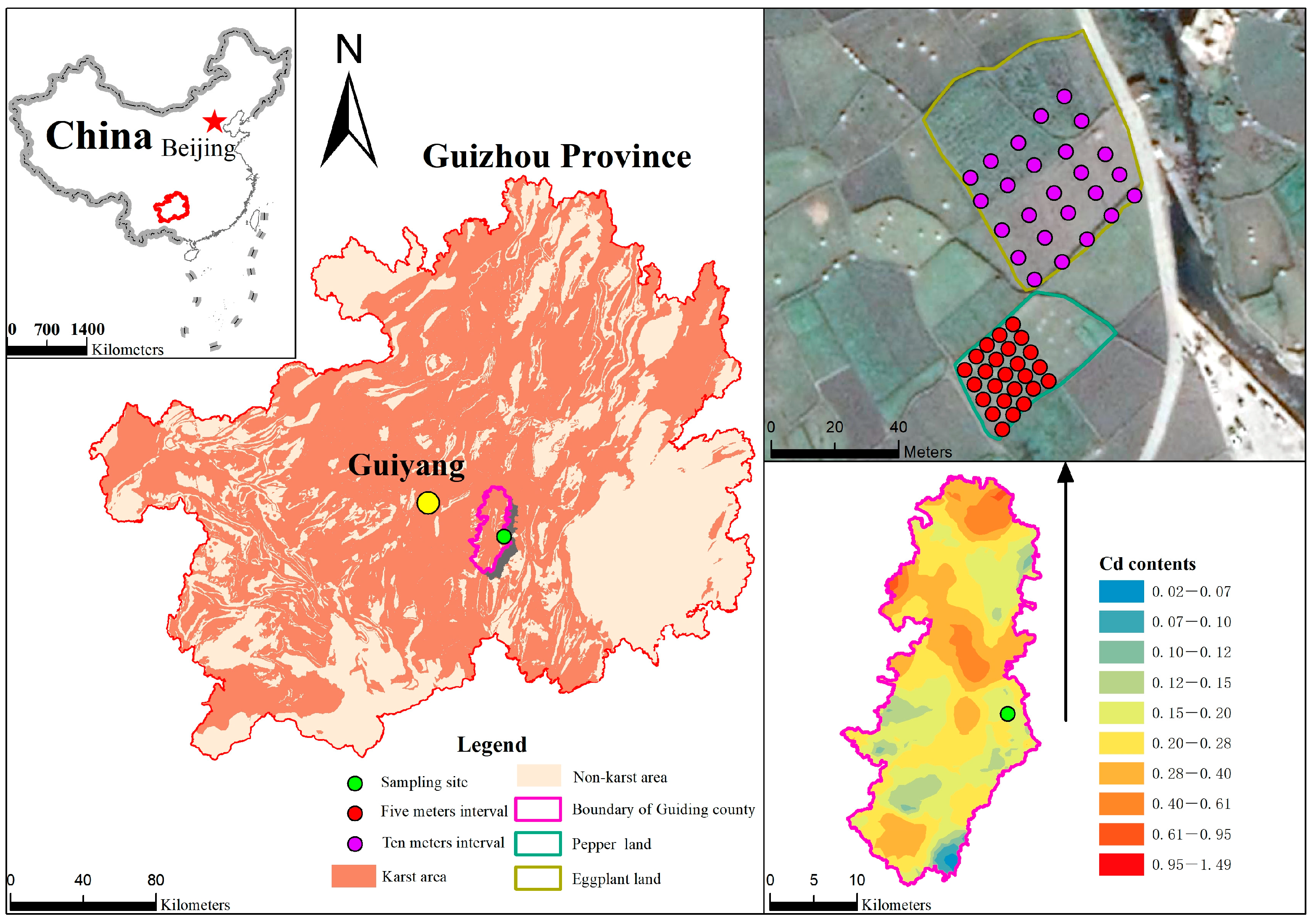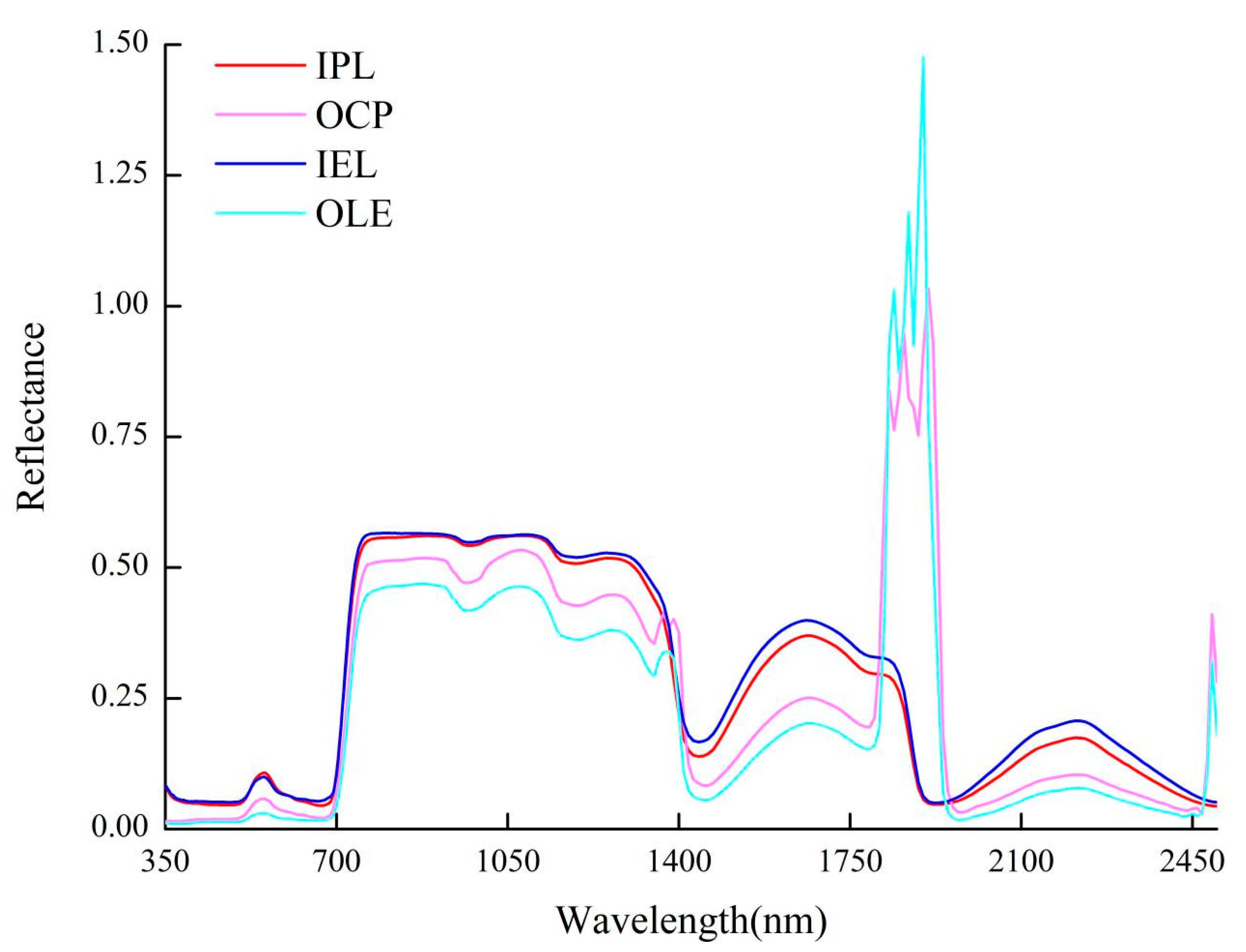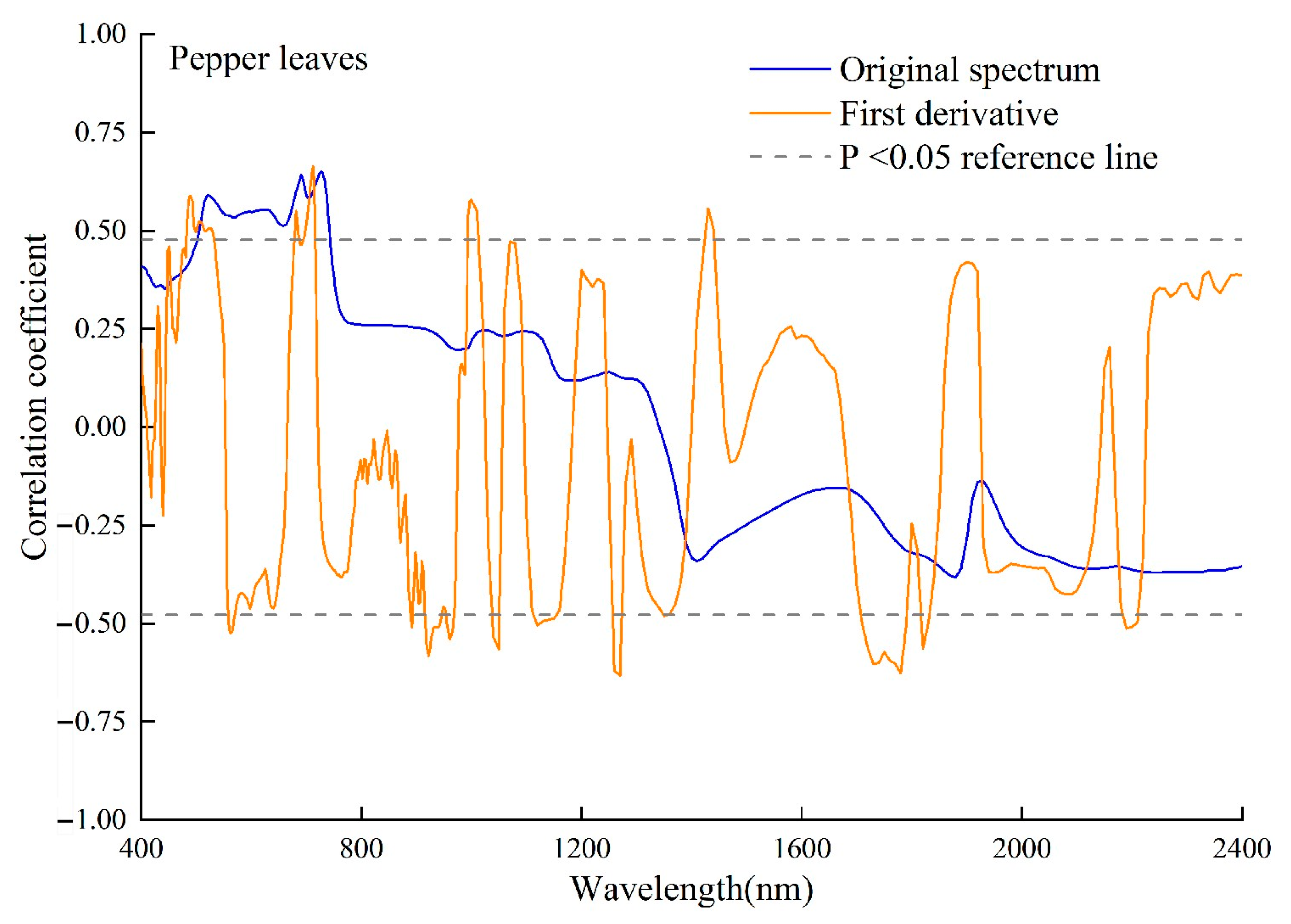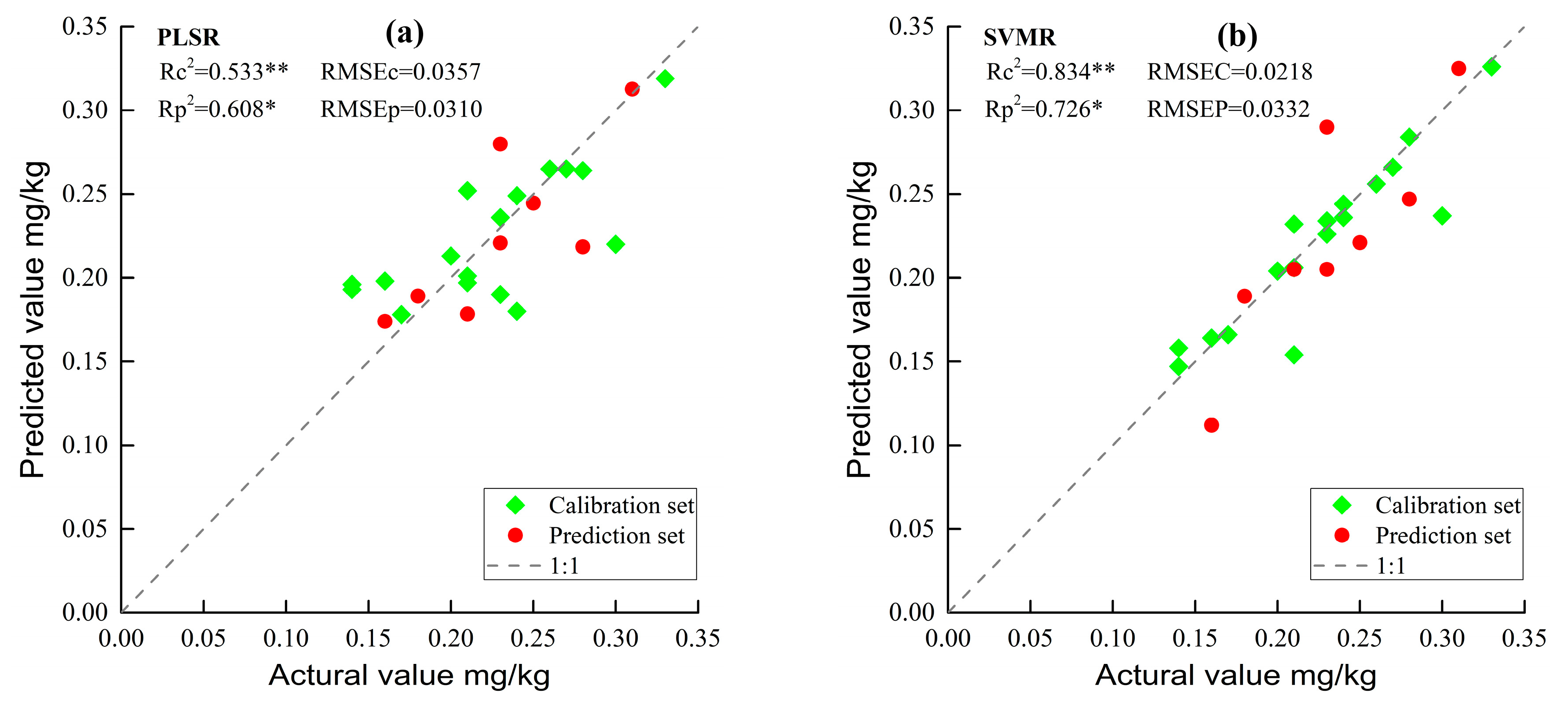Monitoring Cadmium Content in the Leaves of Field Pepper and Eggplant in a Karst Area Using Hyperspectral Remote Sensing Data
Abstract
:1. Introduction
2. Materials and Methods
2.1. Study Area
2.2. Data Acquisition
2.2.1. Sample Collection and Processing
2.2.2. Spectral Data Acquisition and Processing
2.3. Model Construction and Evaluation
2.3.1. Sensitive Wavebands
2.3.2. Partial Least Squares Regression (PLSR)
2.3.3. Support Vector Machine Regression (SVMR)
2.3.4. Model Index Evaluation Method
2.4. Software Platform
3. Results
3.1. Characteristics of Cadmium Accumulation
3.1.1. Characteristics of Cadmium Accumulation in Soil
3.1.2. Characteristics of Cadmium Accumulation in Plants
3.2. Selection of Sensitive Wavebands for Leaf Spectra
3.2.1. Original Spectral Characteristics
3.2.2. Screening of Sensitive Wavebands in Pepper Leaves
3.2.3. Screening of Sensitive Wavebands in Eggplant Leaves
3.3. Prediction and Accuracy Evaluation of the Cd Content in Leaves
3.3.1. Regression Model Analysis of the Cd Content in Pepper Leaves
3.3.2. Regression Model Analysis of the Cd Content in Eggplant Leaves
4. Discussion
5. Conclusions
Author Contributions
Funding
Conflicts of Interest
References
- Wang, Y.; Su, Y.; Lu, S. Predicting Accumulation of Cd in Rice (Oryza Sativa L.) and Soil Threshold Concentration of Cd for Rice Safe Production. Sci. Total Environ. 2020, 738, 139805. [Google Scholar] [CrossRef] [PubMed]
- Zhou, X.; Sun, J.; Tian, Y.; Lu, B.; Hang, Y.; Chen, Q. Development of Deep Learning Method for Lead Content Prediction of Lettuce Leaf Using Hyperspectral Images. Int. J. Remote Sens. 2020, 41, 2263–2276. [Google Scholar] [CrossRef]
- Wei, J.; Gao, J.; Cen, K. Levels of Eight Heavy Metals and Health Risk Assessment Considering Food Consumption by China’s Residents Based on the 5th China Total Diet Study. Sci. Total Environ. 2019, 689, 1141–1148. [Google Scholar] [CrossRef] [PubMed]
- Li, X.; Duan, Q.; Li, J. Hazard and Pollution Analysis of Cadmium in Chinese Domestic Shellfish. Food Sci. 2010, 31, 457–461. (In Chinese) [Google Scholar] [CrossRef]
- Jan, A.T.; Azam, M.; Siddiqui, K.; Ali, A.; Choi, I.; Haq, Q.M.R. Heavy Metals and Human Health: Mechanistic Insight into Toxicity and Counter Defense System of Antioxidants. Int. J. Mol. Sci. 2015, 16, 29592–29630. [Google Scholar] [CrossRef]
- Tariq Rafiq, M.; Aziz, R.; Yang, X.; Xiao, W.; Stoffella, P.J.; Saghir, A.; Azam, M.; Li, T. Phytoavailability of Cadmium (CD) to Pak Choi (Brassica Chinensis L.) Grown in Chinese Soils: A Model to Evaluate the Impact of Soil CD Pollution on Potential Dietary Toxicity. PLoS ONE 2014, 9, e111461. [Google Scholar] [CrossRef]
- Satarug, S.; Baker, J.R.; Urbenjapol, S.; Haswell-Elkins, M.; Reilly, P.E.B.; Williams, D.J.; Moore, M.R. A Global Perspective on Cadmium Pollution and Toxicity in Non-Occupationally Exposed Population. Toxicol. Lett. 2003, 137, 65–83. [Google Scholar] [CrossRef]
- Wu, H.; Liu, Q.; Ma, J.; Liu, L.; Qu, Y.; Gong, Y.; Yang, S.; Luo, T. Heavy Metal(Loids) in Typical Chinese Tobacco-Growing Soils: Concentrations, Influence Factors and Potential Health Risks. Chemosphere 2020, 245, 125591. [Google Scholar] [CrossRef]
- Fang, Y.; Sun, X.; Yang, W.; Ma, N.; Xin, Z.; Fu, J.; Liu, X.; Liu, M.; Mariga, A.M.; Zhu, X.; et al. Concentrations and Health Risks of Lead, Cadmium, Arsenic, and Mercury in Rice and Edible Mushrooms in China. Food Chem. 2014, 147, 147–151. [Google Scholar] [CrossRef]
- Tang, X.; Li, Q.; Wu, M.; Lin, L.; Scholz, M. Review of Remediation Practices Regarding Cadmium-Enriched Farmland Soil with Particular Reference to China. J. Environ. Manag. 2016, 181, 646–662. [Google Scholar] [CrossRef]
- Rafiq, M.T.; Aziz, R.; Yang, X.; Xiao, W.; Rafiq, M.K.; Ali, B.; Li, T. Cadmium Phytoavailability to Rice (Oryza Sativa L.) Grown in Representative Chinese Soils. A Model to Improve Soil Environmental Quality Guidelines for Food Safety. Ecotoxicol. Environ. Saf. 2014, 103, 101–107. [Google Scholar] [CrossRef]
- Zou, M.; Zhou, S.; Zhou, Y.; Jia, Z.; Guo, T.; Wang, J. Cadmium Pollution of Soil-Rice Ecosystems in Rice Cultivation Dominated Regions in China: A Review. Environ. Pollut. 2021, 280, 116965. [Google Scholar] [CrossRef]
- Zhang, C.; Zang, X.; Dai, Z.; Zhang, X.; Ma, Z. Remediation Techniques for Cadmium-Contaminated Dredged River Sediments after Land Disposal. Sustainability 2021, 13, 6093. [Google Scholar] [CrossRef]
- Zeng, S.; Yu, H.; Ma, J.; Liu, J.; Chen, F. Identifying the Status of Heavy Metal Pollution of Cultivated Land for Tradeoff Spatial Fallow in China. Acta Pedol. Sin. 2022, 59, 1036–1047. (In Chinese) [Google Scholar] [CrossRef]
- Zhang, J.; Yang, R.; Chen, R.; Peng, Y. Bioconcentration of Heavy Metals in Soil-Capsicum annuum L. System in Karst Areas of Guizhou Province. Food Sci. 2017, 38, 175–181. (In Chinese) [Google Scholar] [CrossRef]
- Ai, S.; Liu, B.; Yang, Y.; Ding, J.; Yang, W.; Bai, X.; Naeem, S.; Zhang, Y. Temporal Variations and Spatial Distributions of Heavy Metals in a Wastewater-Irrigated Soil-Eggplant System and Associated Influencing Factors. Ecotoxicol. Environ. Saf. 2018, 153, 204–214. [Google Scholar] [CrossRef]
- Liu, W.; Yu, Q.; Niu, T.; Yang, L.; Liu, H. Inversion of Soil Heavy Metal Content Based on Spectral Characteristics of Peach Trees. Forests 2021, 12, 1208. [Google Scholar] [CrossRef]
- Wu, F.; Wang, X.; Liu, Z.; Ding, J.; Tan, K.; Chen, Y. Assessment of Heavy Metal Pollution in Agricultural Soil around a Gold Mining Area in Yitong County, China, Based on Satellite Hyperspectral Imagery. J. Appl. Remote Sens. 2021, 15, 5034. [Google Scholar] [CrossRef]
- Zhang, B.; Guo, B.; Zou, B.; Wei, W.; Lei, Y.; Li, T. Retrieving Soil Heavy Metals Concentrations Based on GaoFen-5 Hyperspectral Satellite Image at an Opencast Coal Mine, Inner Mongolia, China. Environ. Pollut. 2022, 300, 118981. [Google Scholar] [CrossRef]
- Wang, T.; Wei, H.; Zhou, C.; Gu, Y.; Li, R.; Chen, H.; Ma, W. Estimating Cadmium Concentration in the Edible Part of Capsicum Annuum Using Hyperspectral Models. Environ. Monit. Assess. 2017, 189, 548. [Google Scholar] [CrossRef]
- Mirzaei, M.; Verrelst, J.; Marofi, S.; Abbasi, M.; Azadi, H. Eco-Friendly Estimation of Heavy Metal Contents in Grapevine Foliage Using in-Field Hyperspectral Data and Multivariate Analysis. Remote Sens. 2019, 11, 2731. [Google Scholar] [CrossRef] [PubMed]
- Jun, S.; Xin, Z.; Xiaohong, W.; Bing, L.; Chunxia, D.; Jifeng, S. Research and Analysis of Cadmium Residue in Tomato Leaves Based on WT-LSSVR and Vis-NIR Hyperspectral Imaging. Spectrochim. Acta—Part A Mol. Biomol. Spectrosc. 2019, 212, 215–221. [Google Scholar] [CrossRef] [PubMed]
- Zhou, W.; Zhang, J.; Zou, M.; Liu, X.; Du, X.; Wang, Q.; Liu, Y.; Liu, Y.; Li, J. Prediction of Cadmium Concentration in Brown Rice before Harvest by Hyperspectral Remote Sensing. Environ. Sci. Pollut. Res. 2019, 26, 1848–1856. [Google Scholar] [CrossRef]
- Sun, J.; Wu, M.; Hang, Y.; Lu, B.; Wu, X.; Chen, Q. Estimating Cadmium Content in Lettuce Leaves Based on Deep Brief Network and Hyperspectral Imaging Technology. J. Food Process Eng. 2019, 42, e13293. [Google Scholar] [CrossRef]
- Feng, X.; Chen, H.; Chen, Y.; Zhang, C.; Liu, X.; Weng, H.; Xiao, S.; Nie, P.; He, Y. Rapid Detection of Cadmium and Its Distribution in Miscanthus Sacchariflorus Based on Visible and Near-Infrared Hyperspectral Imaging. Sci. Total Environ. 2019, 659, 1021–1031. [Google Scholar] [CrossRef]
- Zou, B.; Tu, Y.L.; Jiang, X.L.; Tao, C.; Zhou, M.; Xiong, L.W. Estimation of Cd Content in Soil Using Combined Laboratory and Field DS Spectroscopy. Spectrosc. Spectr. Anal. 2019, 39, 3223–3231. [Google Scholar] [CrossRef]
- Ahmad, K.; Khan, Z.I.; Kaukab, R.; Wajid, K.; Mehmood, N.; Muqaddas, H.; Abbas, T.; Ullah, M.F.; Elshikh, M.S.; Al Sahli, A.; et al. Health Risk Assessment of Toxic Heavy Metals in Wheat Crop Grown under Domestic Wastewater Irrigation. Fresenius Environ. Bull. 2017, 25, 7643–7650. [Google Scholar]
- Zhang, X.; Chen, D.; Zhong, T.; Zhang, X.; Cheng, M.; Li, X. Assessment of Cadmium (Cd) Concentration in Arable Soil in China. Environ. Sci. Pollut. Res. 2015, 22, 4932–4941. [Google Scholar] [CrossRef]
- Bai, X.Y.; Wang, S.J.; Xiong, K.N. Assessing Spatial-Temporal Evolution Processes Of Karst Rocky Desertification Land: Indications For Restoration Strategies. Land Degrad. Dev. 2013, 24, 47–56. [Google Scholar] [CrossRef]
- Xie, X.; Sun, B.; Hao, H. Relationship between Visible-near Infrared Reflectance Spectroscopy and Heavy Metal of Soil Concentration. Acta Pedol. Sin. 2007, 44, 982–993. (In Chinese) [Google Scholar]
- Xia, F.; Peng, J.; Wang, Q.; Zhou, L.; Shi, Z. Prediction of Heavy Metal Content in Soil of Cultivated Land: Hyperspectral Technology at Provincial Scale. J. Infrared Millim. Waves 2015, 34, 593–599. (In Chinese) [Google Scholar] [CrossRef]
- Shen, L.; Gao, M.; Yan, J.; Li, Z.L.; Leng, P.; Yang, Q.; Duan, S.B. Hyperspectral Estimation of Soil Organic Matter Content Using Different Spectral Preprocessing Techniques and PLSR Method. Remote Sens. 2020, 12, 1206. [Google Scholar] [CrossRef]
- Zhao, J.; Fang, Y.; Chu, G.; Yan, H.; Hu, L.; Huang, L. Identification of Leaf-Scale Wheat Powdery Mildew (Blumeria Graminis F. Sp. Tritici) Combining Hyperspectral Imaging and an SVM Classifier. Plants 2020, 9, 936. [Google Scholar] [CrossRef]
- Lu, Q.; Wang, S.; Bai, X.; Liu, F.; Wang, M.; Wang, J.; Tian, S. Rapid Inversion of Heavy Metal Concentration in Karst Grain Producing Areas Based on Hyperspectral Bands Associated with Soil Components. Microchem. J. 2019, 148, 404–411. [Google Scholar] [CrossRef]
- Rossel, R.A.V.; Taylor, H.J.; McBratney, A.B. Multivariate Calibration of Hyperspectral γ-Ray Energy Spectra for Proximal Soil Sensing. Eur. J. Soil Sci. 2007, 58, 343–353. [Google Scholar] [CrossRef]
- Daud, M.K.; Mei, L.; Azizullah, A.; Dawood, M.; Ali, I.; Mahmood, Q.; Ullah, W.; Jamil, M.; Zhu, S.J. Leaf-Based Physiological, Metabolic, and Ultrastructural Changes in Cultivated Cotton Cultivars under Cadmium Stress Mediated by Glutathione. Environ. Sci. Pollut. Res. 2016, 23, 15551–15564. [Google Scholar] [CrossRef]
- Bingham, F.T.; Page, A.L.; Mahler, R.J.; Ganje, T.J. Growth and Cadmium Accumulation of Plants Grown on a Soil Treated with a Cadmium-Enriched Sewage Sludge. J. Environ. Qual. 1975, 4, 207–211. [Google Scholar] [CrossRef]
- Chen, H.; Yuan, X.; Li, T.; Hu, S.; Ji, J.; Wang, C. Characteristics of Heavy Metal Transfer and Their Influencing Factors in Different Soil-Crop Systems of the Industrialization Region, China. Ecotoxicol. Environ. Saf. 2016, 126, 193–201. [Google Scholar] [CrossRef]
- Luo, K.; Liu, H.; Liu, Q.; Tu, Y.; Yu, E.; Xing, D. Cadmium Accumulation and Migration of 3 Peppers Varieties in Yellow and Limestone Soils under Geochemical Anomaly. Environ. Technol. 2022, 43, 10–20. [Google Scholar] [CrossRef]
- Ye, X.; Xiao, W.; Zhang, Y.; Zhao, S.; Wang, G.; Zhang, Q.; Wang, Q. Assessment of Heavy Metal Pollution in Vegetables and Relationships with Soil Heavy Metal Distribution in Zhejiang Province, China. Environ. Monit. Assess. 2015, 187, 378. [Google Scholar] [CrossRef]
- Ouzounidou, G.; Moustakas, M.; Eleftheriou, E.P. Physiological and Ultrastructural Effects of Cadmium on Wheat (Triticum Aestivum L.) Leaves. Arch. Environ. Contam. Toxicol. 1997, 32, 154–160. [Google Scholar] [CrossRef] [PubMed]







| Type | Number | Min | Max | Mean | SD | CV (%) | KURT | SKEW |
|---|---|---|---|---|---|---|---|---|
| As (mg/kg) | 50 | 1.39 | 2.25 | 1.75 | 0.21 | 12.18 | −0.99 | 0.30 |
| Pb (mg/kg) | 50 | 16.10 | 31.70 | 20.24 | 3.12 | 15.43 | 3.88 | 1.78 |
| Cr (mg/kg) | 50 | 27.50 | 74.00 | 40.48 | 9.04 | 22.34 | 3.94 | 1.85 |
| Cd (mg/kg) | 50 | 0.22 | 0.43 | 0.33 | 0.04 | 12.18 | −0.02 | −0.12 |
| Hg (mg/kg) | 50 | 0.04 | 0.06 | 0.05 | 0.00 | 6.70 | 1.15 | 0.82 |
| SOM (g/kg) | 50 | 31.30 | 61.00 | 44.80 | 8.17 | 18.24 | −1.38 | 0.17 |
| Type | Number | Max (mg/kg) | Min (mg/kg) | Mean (mg/kg) | EF |
|---|---|---|---|---|---|
| Pepper fruits | 18 | 0.033 | 0.019 | 0.025 | 0.069 |
| Pepper leaf | 18 | 0.140 | 0.009 | 0.041 | 0.111 |
| Eggplant fruits | 24 | 0.240 | 0.089 | 0.132 | 0.436 |
| Eggplant leaf | 25 | 0.330 | 0.140 | 0.227 | 0.749 |
| Cd Content in Pepper Leaves | Cd Content in Eggplant Leaves | |
|---|---|---|
| Cd content in fruits | 0.492 * | 0.199 |
| Model Type | Spectral Transformation Form | Model Structure |
|---|---|---|
| PLSR | Original reflectance | |
| PLSR | First derivative reflectance |
| Model Type | Spectral Transformation Form | Calibration Set | Prediction Set | ||||
|---|---|---|---|---|---|---|---|
| Rc2 | RMSEc (mg/kg) | RPDc | Rp2 | RMSEp (mg/kg) | RPDp | ||
| PLSR | Original reflectance | 0.277 | 0.0338 | 1.23 | 0.941 ** | 0.0188 | 2.56 |
| First derivative reflectance | 0.548 ** | 0.0267 | 1.55 | 0.771 * | 0.0299 | 1.61 | |
| SVMR | Original reflectance | 0.988 ** | 0.0072 | 5.76 | 0.107 | 0.0427 | 1.13 |
| First derivative reflectance | 0.546 ** | 0.0269 | 1.54 | 0.897 ** | 0.0264 | 1.82 | |
| Model Type | Spectral Transformation Form | Model Structure |
|---|---|---|
| PLSR | First derivative reflectance |
| Model Type | Spectral Transformation Form | Calibration Set | Prediction Set | ||||
|---|---|---|---|---|---|---|---|
| Rc2 | RMSEc (mg/kg) | RPDc | Rp2 | RMSEp (mg/kg) | RPDp | ||
| PLSR | First derivative reflectance | 0.533 ** | 0.0357 | 1.51 | 0.608 * | 0.0310 | 1.60 |
| SVMR | First derivative reflectance | 0.834 ** | 0.0218 | 2.47 | 0.726 ** | 0.0332 | 1.49 |
Disclaimer/Publisher’s Note: The statements, opinions and data contained in all publications are solely those of the individual author(s) and contributor(s) and not of MDPI and/or the editor(s). MDPI and/or the editor(s) disclaim responsibility for any injury to people or property resulting from any ideas, methods, instructions or products referred to in the content. |
© 2023 by the authors. Licensee MDPI, Basel, Switzerland. This article is an open access article distributed under the terms and conditions of the Creative Commons Attribution (CC BY) license (https://creativecommons.org/licenses/by/4.0/).
Share and Cite
Yi, X.; Wen, X.; Lan, A.; Dai, Q.; Yan, Y.; Zhang, Y.; Yao, Y. Monitoring Cadmium Content in the Leaves of Field Pepper and Eggplant in a Karst Area Using Hyperspectral Remote Sensing Data. Sustainability 2023, 15, 3508. https://doi.org/10.3390/su15043508
Yi X, Wen X, Lan A, Dai Q, Yan Y, Zhang Y, Yao Y. Monitoring Cadmium Content in the Leaves of Field Pepper and Eggplant in a Karst Area Using Hyperspectral Remote Sensing Data. Sustainability. 2023; 15(4):3508. https://doi.org/10.3390/su15043508
Chicago/Turabian StyleYi, Xingsong, Ximei Wen, Anjun Lan, Quanhou Dai, Youjin Yan, Yin Zhang, and Yiwen Yao. 2023. "Monitoring Cadmium Content in the Leaves of Field Pepper and Eggplant in a Karst Area Using Hyperspectral Remote Sensing Data" Sustainability 15, no. 4: 3508. https://doi.org/10.3390/su15043508
APA StyleYi, X., Wen, X., Lan, A., Dai, Q., Yan, Y., Zhang, Y., & Yao, Y. (2023). Monitoring Cadmium Content in the Leaves of Field Pepper and Eggplant in a Karst Area Using Hyperspectral Remote Sensing Data. Sustainability, 15(4), 3508. https://doi.org/10.3390/su15043508






